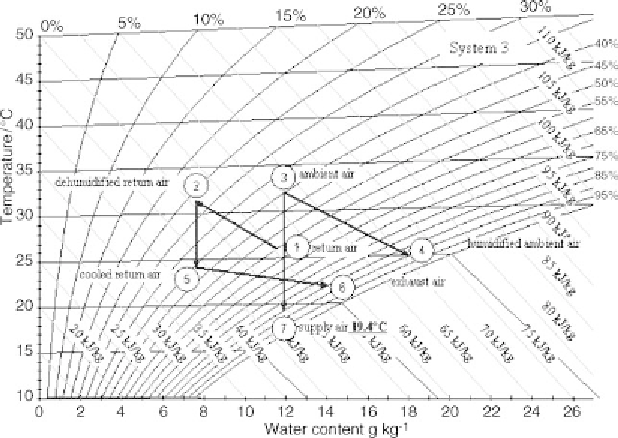Environmental Engineering Reference
In-Depth Information
Figure 5.70
Supply air cooling of system 3 with the contact matrix absorber unit followed by two
spray humidifier heat exchangers
The adsorption wheel reached 19.6
◦
C in system 2 (Figure 5.71). The adsorption
wheel was regenerated at an air temperature of 70
◦
Cwith 12 g kg
−
1
absolute humidity
and a volume flow of 185m
3
h
−
1
. Path 1-2 describes the dehumidification of return
air in AWheel, path 3-4 the humidification of ambient air in the HES, path 2-5 the
cooling of return air in the HES, path 5-6 the humidification of return air in the HES
and path 3-7 the cooling of the supply air in the second HES.
The simplest supply air cooling in system 1, with just one water-sprayed HES,
reaches a supply air temperature of 22
◦
C (Figure 5.72). Path 1-2 shows the humidi-
fication of return air in the HES and path 3-4 the cooling supply air in the HES. This
process can be described as an isenthalpic humidification followed by heating and
humidification at constant relative humidity.
However, the essential advantage of the HEAU over the other two desiccant systems
is the combination of the absorber, the heat exchanger and the humidifier in one single
unit. This allows a very compact construction of the intended air-conditioning system
for residential buildings. Furthermore, the liquid desiccant systems offer the possibility
of loss-free storage of the concentrated solution, which enables the systems to produce
the cooling performance independently of the actual solar irradiation and therefore
avoids the necessity of an extra heating device for regeneration.
For the given design conditions of 200m
3
h
−
1
volume flow, a maximum of 886W
cooling power can be achieved using the most integrated system 4. The results for
the summer design conditions of 32
◦
C, 40% relative humidity outside air, and 26
◦
C,
55% relative humidity room air, are summarized in Table 5.8.

Search WWH ::

Custom Search